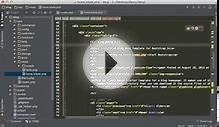
Microsoft® SQL Server™ 2000 supports defining indexes on views. Views are sometimes called virtual tables because the result set returned by the view has the same general form as a table with columns and rows, and views can be referenced the same way as tables in SQL statements. The result set of a non-indexed view is not stored permanently in the database. Each time a query references the view, SQL Server dynamically merges the logic needed to build the view result set into the logic needed to build the complete query result set from the data in the base tables. The process of building the view results is called materializing the view. For more information, see View Resolution.
For a nonindexed view, the overhead of dynamically building the result set for each query that references a view can be substantial for views that involve complex processing of large numbers of rows. Examples include views that aggregate large amounts of data, or join many rows. If such views are frequently referenced in queries, you can improve performance by creating a unique clustered index on the view. When a unique clustered index is created on a view, the view is executed and the result set is stored in the database in the same way a table with a clustered index is stored. For more information about the structure used to store clustered indexes, see Clustered Indexes.
Another benefit of creating an index on a view is that the optimizer starts using the view index in queries that do not directly name the view in the FROM clause. Existing queries can benefit from the improved efficiency of retrieving data from the indexed view without having to be recoded.
Creating a clustered index on a view stores the result set built at the time the index is created. An indexed view also automatically reflects modifications made to the data in the base tables after the index is created, the same way an index created on a base table does. As modifications are made to the data in the base tables, the data modifications are also reflected in the data stored in the indexed view. The requirement that the view's clustered index be unique improves the efficiency with which SQL Server can find the rows in the index that are affected by any data modification.
You must have set specific SET options before you can create an index on a view. The query optimizer will not consider the index for any subsequent SQL statements unless the connection executing the statement has the same option settings. For more information, see SET Options That Affect Results.
Indexed views can be more complex to maintain than indexes on base tables. You should create indexes only on views where the improved speed in retrieving results outweighs the increased overhead of making modifications. This usually occurs for views mapped over relatively static data, that process many rows, and are referenced by many queries.
The first index created on a view must be a unique clustered index. After the unique clustered index has been created, you can create additional nonclustered indexes. The naming conventions for indexes on views are the same as for indexes on tables. The only difference is that the table name is replaced with a view name.
All indexes on a view are dropped if the view is dropped. All nonclustered indexes on the view are dropped if the clustered index is dropped. Nonclustered indexes can be dropped individually. Dropping the clustered index on the view removes the stored result set, and the optimizer returns to processing the view like a standard view.
Although only the columns that make up the clustered index key are specified in the CREATE UNIQUE CLUSTERED INDEX statement, the complete result set of the view is stored in the database. As in a clustered index on a base table, the b-tree structure of the clustered index contains only the key columns, but the data rows contain all of the columns in the view result set.
Traffic statsRELATED VIDEO













